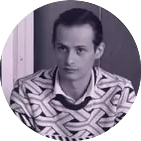Adrian Dica

|
Adrian Dica (b. 1984 Alexandria) is a Romanian painter and he currently lives and works in Bucharest. He studied Fine Arts at the National University of Arts in Bucharest (UNARTE). In 2014 he obtained a BA of Fine Arts degree and in 2016 a MA at the same department, both at Prof. Marcel Bunea. He was awarded UGARTE Excellence Diploma for Painting for his BA artworks.
The general technique principle concerns several cycles of construction-deconstruction, addition-extraction of pictorial matter, and of elements of a plastic discourse. These favors the “coexistence” of the experimental elements and of the accidental factor assumed with a “correct” technical, psychological and historical approach.
|
|---|
Layers of Meaning – A Romanian Artist from Bucharest Redefining Technique
Artist's Journey: Achievements and Exhibitions (2012-2019)
In the same year, he was awarded the 3rd Prize and also with Special Prize at Juventus Contemporary Awards by Triade Foundation in Timisoara. In the next year, The Ministry of Culture of the Republic of Moldova awarded him the Excellence Prize for painting at The National Museum of Moldova during BIP Chisinau.
The 2012-2016 artistic work period includes national and international group exhibitions such as Via Pontika Youth Festival (Balchik, Bulgaria), Transform Art in Education 2014 (Brâncuși Hall, Palace of Parliament, Bucharest), and Transform 2016 at the National Museum of Contemporary Arts Zagreb, Croatia or Die Natur Des Kunstlers (Vienna, Austria). In 2017 he was awarded Prize for Painting by the National Union of Artists and was a finalist at Teodor Moraru National Award. In 2018 exhibited at Huntenkunst Focus on Romania – Central Pavilion, representing Romania, and in the same year, he exhibited at WIPO Geneva, CH. He was awarded Painting Prize at Balassi Hungarian Cultural Institut in Bucharest in 2018.
His works have been exhibited in solo and group shows in Romania or Europe in private or public institutions such National Museum of Arts Bucharest, National Museum of Contemporary Arts Zagreb, or WIPO Geneva. He has two important retrospectives at the Palace of Parliament – Bucharest, 2017 and Arthalle Gallery, 2019 – Bucharest.
His work is part of many prestigious private and public collections such as the BRD GS Art Collection, Deputy Chambers Art Collection Romania, or Jecza Museum Timisoara Art Collection.
Artist Statement
Sometimes we reject pink as it seems the color of girls, of women or men of certain ages, of funny stupid dolls, of posh ladies, kid diapers, little girls’ clothes. It’s a disgrace, a joke, a cliche, a laugh. But, yet, the prettiness of pink reveals, by contrast, a harsh and adult acknowledgment of the serious side of our lives. That’s why Adrian Dica uses pink and garbage in his paintings, although at first sight, the association seems meaningless.
As long as we deepen into his works we discover it’s not about the simplest series of pinky brushstrokes thrown upon an image of a pile of dirt or that of a preapocaliptical scenery, it’s the reflection of our lives. We all have good and bad, happiness and sadness, sunny summers and icy winters, a unity of opposites and paradoxes that makes our lives meaningful. Adrian Dica succeeds in making out of his art an image of life in itself and meeting points with the others’ conscience.
In apparent opposition with pink, the industrial ruins of a previous era are personal interior landscapes, conditioned by the time and the space of childhood significant memories. The physical structures he paints are abstract mental schemes that belong to the timelessness of a space-based on perception. The artistic speech is intimate and imaginative, revealing the existence of conscience: the attitude of detachment and revaluation of memories.
From a technical point of view the artist aimed at certain correctness validated by their own experience and by the methods already established. Starting from the techniques specific to the pictorial language (oil, acrylic on canvas) he tried to experiment based on a final expressiveness. Without developing a strict, repetitive method he integrated into the technique used various variables ranging from acrylic colors and oils to using water based stains, textural sprays, industrial paint, and pigments. The brush is generally used for counterpoint, the rest of the image is constructed using a palette knife, chassis wedges, scrapers, paint sprayers.
|
Are you interested in a commission artwork made by Adrian just for you?
|
|---|
Adrian Dica is present in these categories:
Need more help?
|
Certificate of Authenticity |
14 days money back return policy |
Safe checkout guaranteed |
|---|









